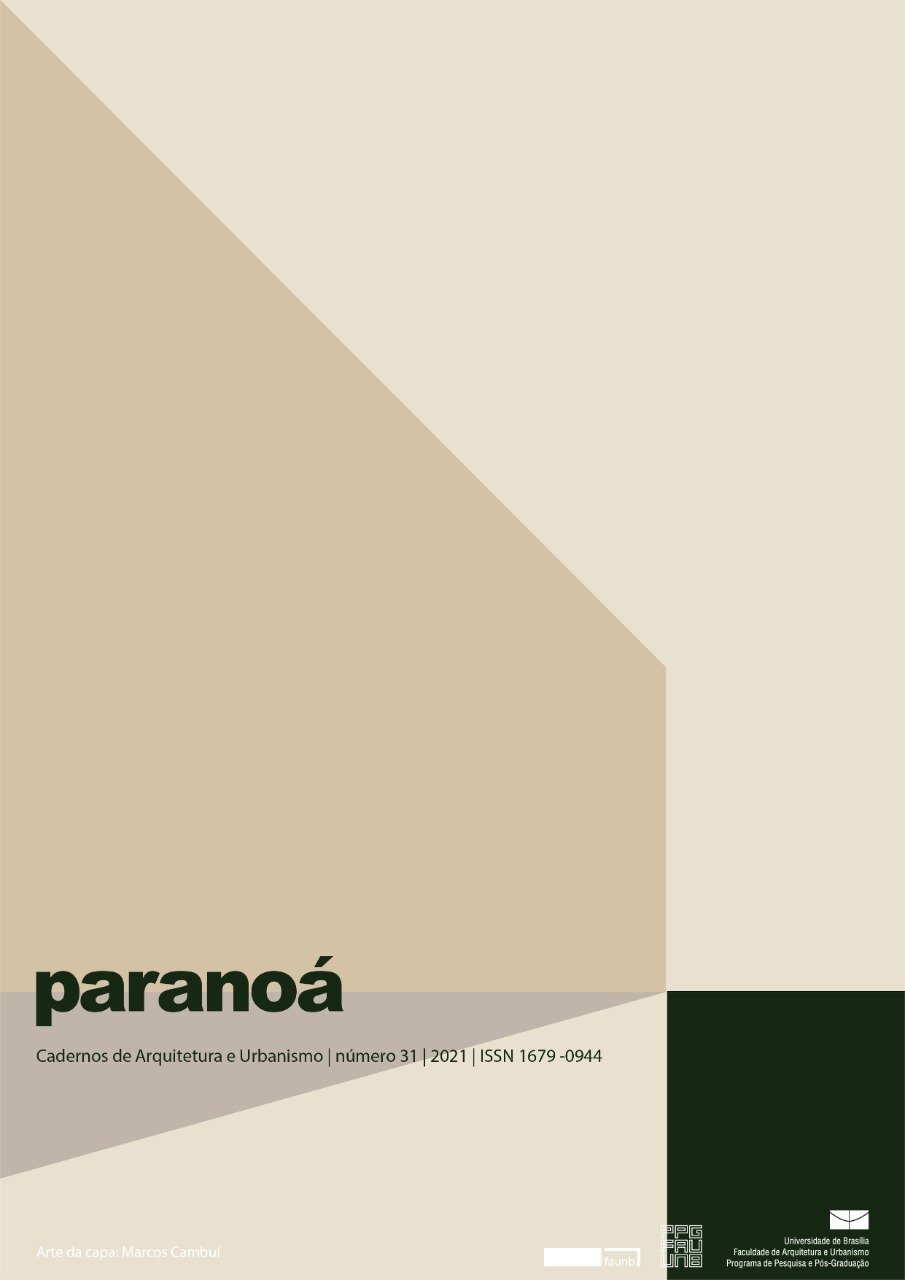From "form" to "memory." From houses of no site to the city as a determinant in Peter Eisenman's projects
DOI:
https://doi.org/10.18830/issn.1679-0944.n31.2021.07Keywords:
Post-modern architecture, conceptual architecture, Peter Eisenman, cities of artificial excavation, form, memoryAbstract
Over the years, Peter Eisenman's approach to his criticisms of current architecture has changed. In the scope of this article, however, the search for it has never ceased to be the architecture’s autonomy, starting, initially, from the support in conceptual art and linguistics, and, later, migrating to post-structuralist interpretations. The criticism that was previously configured in an architecture devoid of external references, then comes to have in the urban context the great agent of the design of his projects. Thus, this article aims to present Eisenman's critical architecture and discuss how it ceases to be so exclusive of its contextual elements and starts to relate to the memory of the places in which it is inserted. Therefore, we sought to read authors who influenced Eisenman's work, as well as texts by the architect himself and his critics, with the intention of better understanding the environment and the reflections that provided such architectural productions, in addition to the transition from the first one to the second one. In this study, the main differences between both actions were identified, but it was also concluded the existence of a conversion regarding the distancing of the observer/user from the two different series of projects.
Downloads
References
BRONSTEIN, Laís. The city of criticism to the modern movement. In: INTERNATIONAL PLANNING HISTORY SOCIETY, 11., 2004, Barcelona. Anais […]. Barcelona: Universitat de Barcelona, 2004. p. 1-12.
BUCHLOH, Benjamin. Conceptual art 1962-1969: from the aesthetic of administration to the critique of institutions. October, Cambridge, v. 55, p. 105-143, winter 1990.
COLQUHOUN, Alan. Uma maneira de ver a presente situação [1983]. In: Modernidade e tradição clássica. Ensaios sobre arquitetura. 1a ed. São Paulo: Cosac & Naify, 2004. p. 185-190.
DELECAVE, Jonas. Em busca de uma autonomia disciplinar: John Hejduk e o ensino de arquitetura na Cooper Union, 1964 – 1971. 2015. Dissertação (Mestrado em Arquitetura) - Universidade Federal do Rio de Janeiro, Rio de Janeiro, 2015.
DUBOIS, Jean; GIACOMO, Mathée; GUESPIN, Louis; MARCELLESI, Christiane; MARSELLESI, Jean-Baptiste; MEVEL, Jean-Pierre. Dicionário de linguística. São Paulo: Cultrix, 2006.
EISENMAN, Peter. O fim do clássico: o fim do começo, o fim do fim [1984]. In: NESBITT, Kate (org.). Uma nova agenda para a arquitetura: antologia teórica (1965-1995). São Paulo: Cosac & Naify, 2006. p. 233-252.
EISENMAN, Peter; ROBERTSON, Jaquelin. Koch/Friedrichstrasse, block 5. Architectural design, v. 53, n. 9, p. 91-93, London, jan. 1983.
FOUCAULT, Michel. O a priori histórico e o arquivo. In: A arqueologia do saber. Rio de Janeiro: Forense Universitária, 2012, p. 143-149. 1969.
FREUD, Sigmund. Nota sobre o bloco mágico [1925]. In: Obras completas. v. 16. São Paulo: Cia das Letras, 2011, p. 241-246.
HAYS, K. Michael. Architecture’s desire. Reading the late avant-garde. Cambridge: MIT Press, 2010.
KLEIHUES, Josep Paul. New building areas, buildings and projects. In: Internationale Bauausstellung Berlin 1987 project report. English edition. Berlin: Felgentreff & Goebel GmbH, 1991. p. 6-9.
KOSUTH, Josef. A arte depois da filosofia [1969]. In: FERREIRA, Glória; COTRIM, Cecilia (org.). Escritos de artistas: anos 60/70. Rio de Janeiro: Zahar, 2006.
LUCENA, Francisco. Peter Eisenman: autonomia crítica da arquitetura. 2010. Dissertação (Mestrado em História Social da Cultura) - Pontifícia Universidade Católica do Rio de Janeiro, Rio de Janeiro, 2010.
PASSARO, Andrés. Linguística e estruturalismo na arquitetura dos anos 70. In: OLIVEIRA, Beatriz S.; LASSANCE, Guilherme; ROCHA-PEIXOTO, Gustavo; BRONSTEIN, Laís (org.). Leituras em teoria da arquitetura. Rio de Janeiro: Viana & Mosley, 2009. v. 1, p. 128-161.
SCHWARTZ, Joan; COOK, Terry. Arquivo, Documentos e Poder: A construção da memória moderna. Registro - Revista do Arquivo Público Municipal de Indaiatuba. São Paulo: Fundação Pró-Memória de Indaiatuba, v. 3, n. 3, p. 15-30, jul. 2004.
SOLÀ-MORALES, Ignasi. Forma, memoria, acontecimiento. AV monografías, Madrid, v. 53, n. 2, p. 20-23, mayo/jun. 1995.
Downloads
Published
How to Cite
Issue
Section
License
Copyright (c) 2021 Paranoá: journal of Architecture and Urbanism

This work is licensed under a Creative Commons Attribution 4.0 International License.
Autores que publicam nesta revista concordam com os seguintes termos:
- Autores mantém os direitos autorais e concedem à revista o direito de primeira publicação, com o trabalho simultaneamente licenciado sob a Licença Creative Commons Attribution que permite o compartilhamento do trabalho com reconhecimento da autoria e publicação inicial nesta revista. http://creativecommons.org/licenses/by/4.0
- Autores têm autorização para assumir contratos adicionais separadamente, para distribuição não-exclusiva da versão do trabalho publicada nesta revista (ex.: publicar em repositório institucional ou como capítulo de livro), com reconhecimento de autoria e publicação inicial nesta revista.
- Autores têm permissão e são estimulados a publicar e distribuir seu trabalho online (ex.: em repositórios institucionais ou na sua página pessoal) a qualquer ponto antes ou durante o processo editorial, já que isso pode gerar alterações produtivas, bem como aumentar o impacto e a citação do trabalho publicado (Veja O Efeito do Acesso Livre).















